Now 215 Brits have caught Indian variant: Cases of mutant strain have nearly TRIPLED in week – as scientists warn decision to put India on red list came ‘weeks to late’ with thousands of travellers making last-minute dash to beat Friday’s 4am deadline
- Data from Government’s official Covid variant tracking scheme show there’ve been 215 cases of B.1.617 strain
At least 215 Britons have now caught the Indian coronavirus variant that is causing international alarm, MailOnline can reveal — amid warnings Number 10 was ‘weeks too late’ with its travel ban.
Data from the Government’s official Covid variant tracking programme show cases of the mutant strain have nearly tripled from the 77 detected last week.
It suggests one in 200 swabs analysed by British scientists are positive for the B.1.617 variant, which scientists told MailOnline was a ‘very troubling’ number.
The development comes after other scientists and senior Labour politicians slammed the Government for allowing thousands of travellers from India to pour into the UK every week despite knowing about the variant for nearly a month.
Number 10 only announced India was being added to the UK’s travel ‘red list’ yesterday, and the measures don’t start until 4am on Friday. At least 5,000 of people are due to arrive in Britain from India before the travel restrictions come into effect, as a desperate scramble to beat the quarantine deadline ensues.
Boris Johnson will tonight hold a press conference for the first time in two weeks, where he’ll likely face questions over the travel ban delay.
Amid growing numbers of the variant at home and the spiralling epidemic in India, the PM has had to cancel a scheduled visit to Delhi next week.
Reacting to the new Indian variant cases, Professor Paul Hunter, an epidemiologist from the University of East Anglia, added: ‘It does look like this is growing rather more quickly than it should be while we’re in this sort of lockdown.
‘It is still a little bit early to know what’s really going on with this variant, but the signs are not looking good.’
The data, published by the Covid-19 Genomics UK Consortium, shows the Indian variant has been spotted in every part of the UK except Northern Ireland – with 198 in England, 10 in Scotland and seven in Wales.
Professor Hunter said it was ‘almost certain’ that there are more cases of the Indian variant because it can take two or three weeks for sequences to be analysed and published.
It is feared B.1.617 spreads easier than older strains and has mutations which help it evade vaccines — but to what degree remains unclear. Scientists do not believe it is any deadlier than the strains currently circulating in Britain.
Doctors in India claim there has been a sudden spike in Covid admissions among people under 45, who have traditionally been less vulnerable to the disease.
There have been anecdotal reports from medics that young people make up two third of new patients in Delhi. In the southern IT hub of Bangalore, under-40s made up 58 percent of infections in early April, up from 46 percent last year.
There is still no proof younger people are more badly affected by the new strain.
As part of the travel ban, anyone who is not a UK or Irish resident or a British citizen will be banned from entering the country if they have been in India in the last 10 days. British nationals will need to isolate in a quarantine hotel.
No10’s travel ban has sparked a ‘desperate frenzy’, with families trying to beat the Friday deadline and avoid having to quarantine in a hotel. Travel agents say that a standard £400 economy ticket from India to the UK has soared to £2,000 due to a shortage of seats on planes over the next three days.
Sixteen direct flights from India — which carried about 300 passengers each before airlines brought in social distancing guidelines — were scheduled to land in the UK between the announcement of the ban yesterday and the deadline coming into action. Thousands more will travel on in-direct routes.
Suresh Kumar, chairman of Indra Travel, told The Telegraph most Britons trying to return are in India on emergency visas for family funerals or weddings or on business, as well as students.
Universities warned that the travel ban would leave 10,000 international students scrambling to return to UK campuses before Friday.
Vivienne Stern from Universities UK said she had not been given any assurances that there was enough capacity in quarantine hotels to house the returning students.
As Britons scramble to get back to the UK, travellers have complained of two-hour queues at border control at Heathrow Airport, where five flights from India are due to arrive today.
Labour slammed the Government for not banning arrivals immediately despite the Indian variant being under investigation by UK officials for almost three weeks. Sir Patrick Vallance’s predecessor admitted ministers were too slow to respond to the new B.1.617 strain claiming the ban was ‘taken a bit too late in truth’.
Tonight’s press conference will be Mr Johnson’s first in a fortnight. He is expected to give a general update about the UK’s Covid crisis and vaccination programme.
The PM is facing growing calls to ease lockdown quicker after there were just four Covid deaths yesterday — the lowest in seven months — and the jab drive hit the milestone of fully vaccinating 10million Brits. A total of 33m have had at least one injection.
The Indian variant was first identified internationally in October and detected in the UK on February 22. Two key mutations set it apart from others – named E484Q and L452R – with both of them found on the ‘spike’ that the virus uses to latch onto human cells.
These are not thought to be key mutations of any of the other variants on Public Health England’s list, but have appeared in virus samples before.
Those alterations are thought to make the virus more transmissible, and lab studies suggest it can escape antibodies — a key part of the body’s Covid immune response. But because the E484Q mutation is rare, scientists aren’t sure to what degree it will change the way the virus behaves.

No10 only announced India was being added to the UK’s travel ‘red list’ yesterday, and the measures won’t come into until 4am on Friday. India is currently battling a second wave of cases, but the numbers per capita are nowhere near levels seen during the UK’s winter peak

The UK’s hugely successful vaccination programme and brutal four-month lockdown has squashed deaths to double-digits. But India’s fatalities have started to climb on the back of a spike in infections
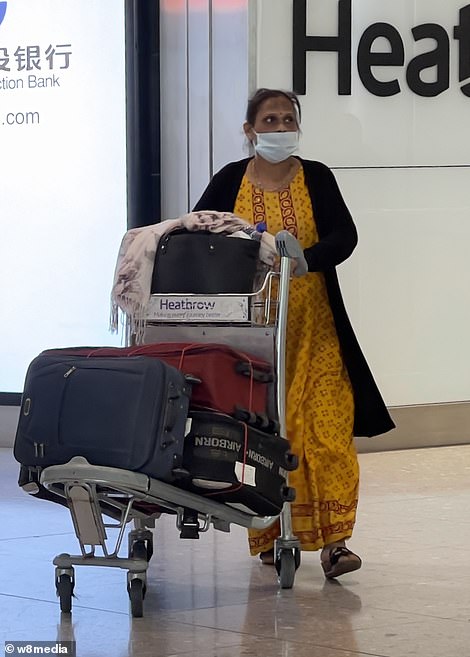

Passengers arrive at Heathrow Terminal 2 from Mumbai this afternoon as travel agents warn of a desperate scramble to beat Friday’s quarantine deadline
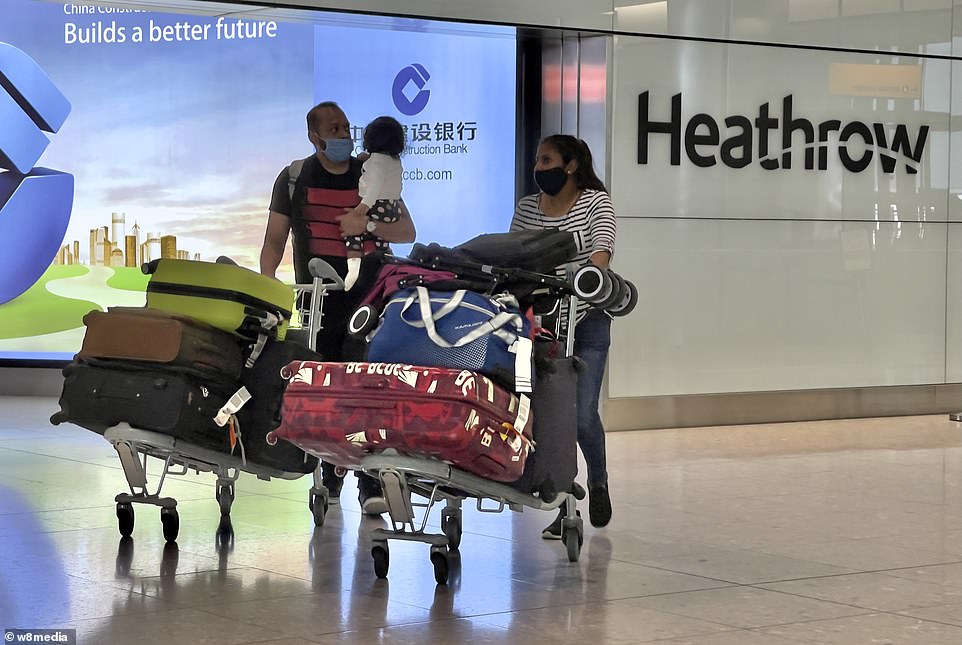
Travel agents say that a standard £400 economy ticket from India to the UK has soared to £2,000 due to a shortage of seats on planes over the next three days
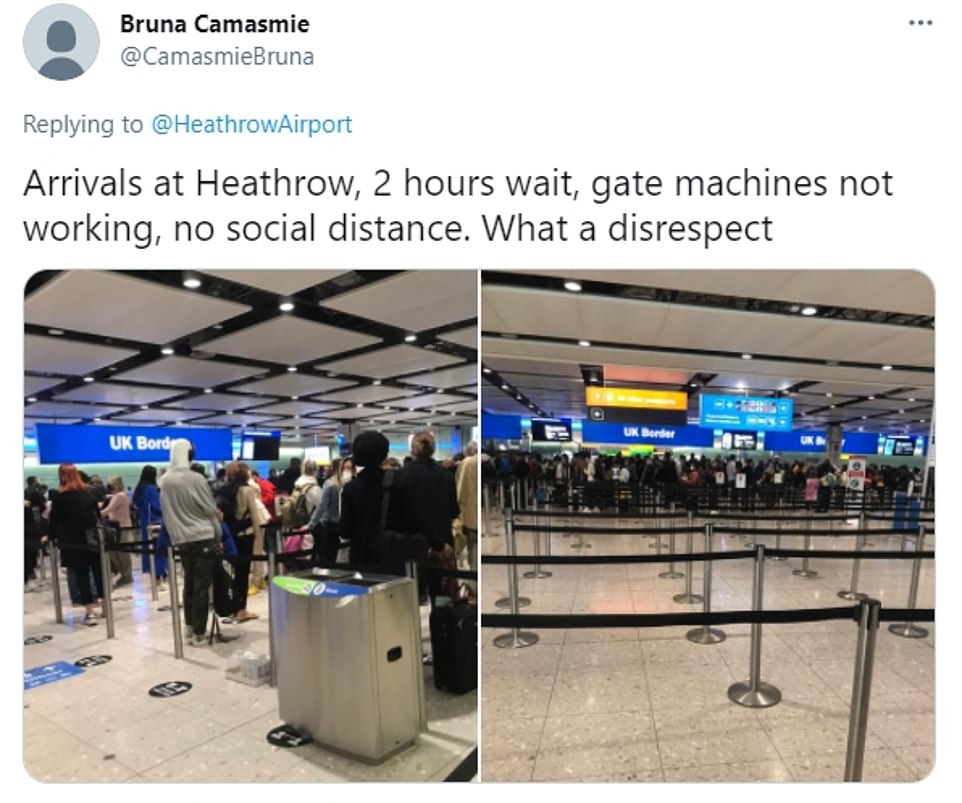
Bruna Camasmie complained of two-hour queues at border control at Heathrow Airport, where five flights from India are due to arrive today
Professor Hunter said it was unclear if all 215 of the B.1.617 variant reported by COG-UK were the Indian strain.
He told MailOnline the group, tasked with monitoring and studying emerging variants of the virus, may have included some substrains which are almost identical to the Indian version but have slight differences in their mutations.
Public Health England updates its variant data every week, which is why its website claims there have only been 77 cases. PHE’s last update was on April 14.
Earlier today, Sharon Peacock, the head of COG-UK and professor of public health and microbiology at the University of Cambridge, tried to calm fears about the strain’s spread.
She highlighted that the Kent variant took off in the UK within weeks of emerging last winter, whereas the Indian variant has been in circulation there since last October.
It suggests India may have suffered its latest wave regardless of which coronavirus was dominant at the time. But Professor Peacock claimed there was enough concern to warrant slowing the number of cases coming into the UK.
‘This is an important step in controlling further introduction of this variant into the UK,’ she said.
‘The number of B.1.617 genomes detected in the UK has risen in the last three weeks.
‘Even though this is at or less than 1 per cent of the genomes sequenced in the UK overall, the upward trend in cases warrants action whilst ongoing uncertainties over the level of threat posed by this variant are evaluated.’
She said scientists were also unsure whether the mutations mean the variant can evade the effectiveness of vaccines or natural immunity.
The Indian variant’s E484Q mutation is very similar to the one found in the South African and Brazil variants known as E484K, which can help the virus evade antibodies.
The South African variant is thought to make vaccines about 30 per cent less effective at stopping infections, but it’s not clear what effect it has on severe illness.
Professor Peacock said more work was needed to determine whether the Indian variant should move from being one under investigation, as at present, to a variant of concern.
Professor Sir Mark Walport, former chief scientific adviser to the Government, said he was confident the jab is more transmissible than other strains based on spiralling case numbers in India.
He also admitted the ban on travel from the country had come too late.
He told BBC Breakfast: ‘These decisions are almost inevitably taken a bit too late, in truth, but what’s absolutely clear is that this variant is more transmissible in India.
‘You can see that it’s becoming the dominant variant, and the other concern about it is that it has a second change in the spike protein which may mean that it’s able to be a bit more effective at escaping an immune response, either a natural one or vaccine-induced one, so there’s good reasons for wanting to keep it out of the country if at all possible.
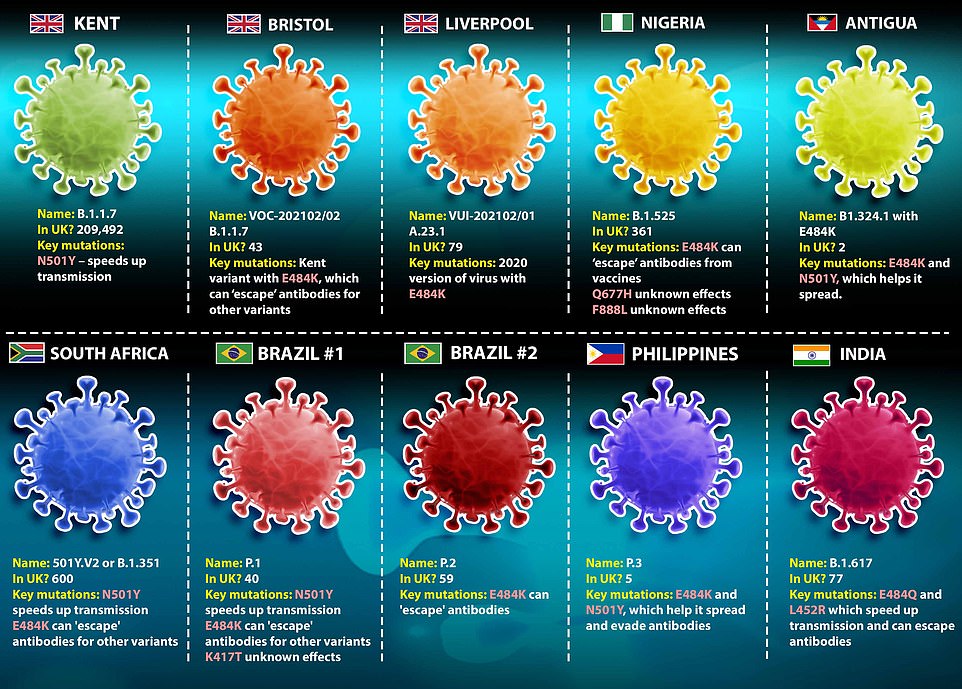
The Covid variants circulating in the UK: Matt Hancock revealed yesterday that 103 cases of the Indian variant had been picked up in Britain, but Public Health England’s site has not been updated. It still says there have been 77 infections
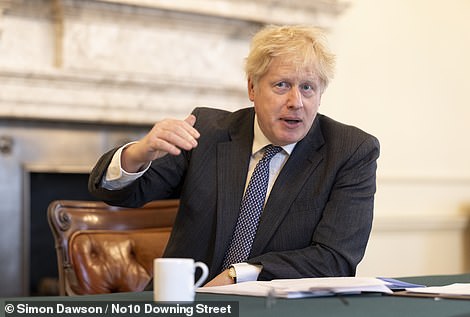
Boris Johnson, pictured this morning inside No10, will hold a press conference tonight amid growing concerns about the Indian coronavirus variant
‘What we need to do is get the population vaccinated and also get booster vaccines prepared that will be able to deal with these new variants – so buying time… against these new variants is really important.’
Thousands of people will arrive in Britain from India this week before the ‘red list’ travel restrictions come into effect on Friday.
Seven flights from the country arrived at Heathrow airport yesterday, with at least 16 scheduled to land before the tighter rules come into place. Flights run by BA, Virgin Atlantic and Air India are due from Mumbai, Delhi, Bengaluru and Hyderabad.
Before Friday, travellers from India will have to provide a negative coronavirus test in the three days before flying and then quarantine at home in the UK for ten days. Arrivals can use public transport to travel to their quarantine destination.
From Friday, only British or Irish nationals, or those with UK residence rights, can enter on flights from India. They will have to quarantine in a hotel for ten days.
Earlier this year, amid concerns about the Kent variant, India limited flights between the countries to 30 a week, compared with almost 70 previously.
Suresh Kumar, chairman of Indra Travel, a family firm he set up 42 years ago, told The Telegraph that ticket prices had soared up to five times as Brits rush to avoid quarantining in a hotel when they return.
He said: ‘It’s become very busy and flights are not available due to the demand. Prices are four or five times what they were last week.
‘A normal £400 economy seat from Delhi is [now] anything up to £2,000. Even if you go for business or first class, there are not many around. They are over £3,000. There was concern India was going to be added but it was still quite a shock. People are concerned and desperate to get back and in a frenzy.’
Labour slammed No10 for delaying the India ban, claiming that it had put British lives in danger and risked sparking more outbreaks of the variant at home.
Shadow home secretary Nick Thomas-Symonds telling LBC yesterday: ‘As Labour has warned for months, failing to introduce strong protections at the border has left us exposed to mutations of the virus, which has now lead to dangerous outbreaks in the UK.
‘It is not good enough to try and shut the door after the horse has bolted, by adding countries onto a red list when it is too late. What’s needed is an urgent comprehensive hotel quarantine system.’
Meanwhile Labour chairwoman, Yvette Cooper, said the variant had been under investigation for almost three weeks.
She told The Times: ‘The India variant has been under investigation for almost three weeks and other neighbouring countries with lower rates of infection were added to the red list ten days ago.’
Yesterday Matt Hancock told MPs that the government had made the ‘difficult’ decision to place India in the highest level of restrictions from 4am on Friday.
Mr Hancock claimed the ‘vast majority’ of cases in the UK were linked to international travel. He said: ‘After studying the data and on a precautionary basis we have made the difficult but vital decision to add India to the red list.’
Figures show there are now more than 200,000 confirmed Covid cases a day in India, which is still a far cry from the infections per capita seen at the peak of the UK’s winter crisis.
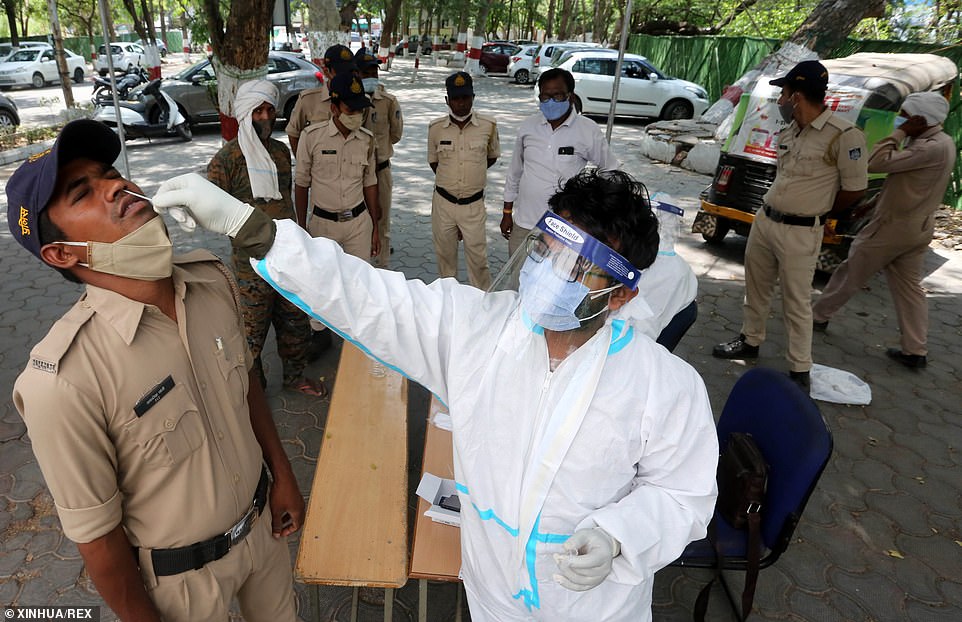
A health worker collects a swab from a policeman in Bhopal, the capital city of India’s Madhya Pradesh state
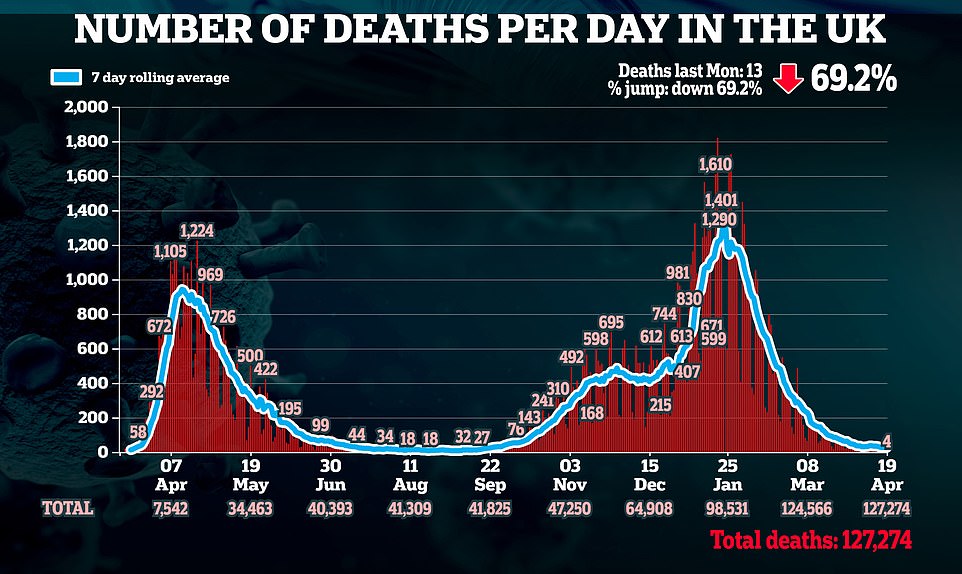


India is recording fewer than 200 daily cases per million people at the moment compared to the 800-plus per million in Britain in January.
PHE’s Professor Peacock suggested this may point to the Indian strain being less infectious than the Kent one which fuelled the UK’s crisis.
Yesterday, a joint statement from the British and Indian government said Boris Johnson’s trip – already scaled back – will not go ahead next week ‘in light of the current situation’.
Mr Hancock said the latest move means ‘anyone who is not a UK or Irish resident or a British citizen cannot enter the UK if they’ve been in India in the previous 10 days’.
‘UK and Irish residents and British citizens who have been in India in the past 10 days before their arrival will need to complete hotel quarantine for 10 days from the time of arrival.’
He added: ‘India is a country I know well and love. Between our two countries we have ties of friendship and family. I understand the impact of this decision but I hope the House will concur that we must act.’
The news comes after an expert warned the Indian coronavirus variant could ‘pose a threat’ to Mr Johnson’s roadmap out of lockdown.
Professor Danny Altmann, an Imperial College London immunologist, said there were vaccinated vulnerable Britons who could ‘still be caught out by variants like this’.
PHE currently lists it as a ‘variant under investigation’, a tier below other troublesome strains including the Kent, South African and Brazilian variants.
But Professor Altmann said he expects, ‘from everything I’ve seen is that it will become a variant of concern.’
SAGE member Professor Andrew Hayward backed calls for India to be put on the ‘red list’ to buy experts time to study the variant in more detail.
The infectious disease expert urged the Government to ‘err on the side of caution and act sooner rather than later’.
But top experts studying Britain’s Covid variants said the Indian variant was unlikely to ever take off in the UK because its mutations were ‘not top tier’.=
Dr Jeffrey Barrett, director of the Covid-19 Genomics Initiative at the Wellcome Sanger Institute, told the BBC Radio 4 Today programme on Monday: ‘This variant has a couple of mutations that are among those that we think are important that should be watched carefully.
‘But they’re actually probably not at the very kind of top tier of mutations, for example in the B.1.1.7 – or Kent variant – or the South African variant, that generate the most concern.’
Dr Barnett said the rise of the Indian variant had happened at the same time India suffered a third wave, which may explain its higher prevalence.
India’s health system is collapsing as Covid-19 spreads faster than ever, gravediggers burn piles of victims to keep up and crematorium furnaces MELT due to round-the-clock use
India‘s health system is collapsing under the fastest spreading coronavirus surge since the pandemic started.
Another 259,170 cases were recorded on Tuesday, the world’s highest daily rate, and 1,761 deaths, the country’s highest ever daily toll, after a new variant of Covid emerged which scientists fear could partly evade vaccines.
The British government added the country to its ‘red list’ on Monday but was accused of acting weeks too late as more than 100 people in the UK have now tested positive for this Indian variant since the end of March, while some 900 people have been arriving on flights from India every day.
Delhi imposed a week-long lockdown last night as ambulances catapulted from one hospital to another, trying to find an empty bed.
The city of 29 million people has fewer than 100 beds with ventilators, and fewer than 150 beds available for patients needing critical care.
In the western state of Gujarat, many crematoria in Surat, Rajkot, Jamnagar and Ahmedabad are operating around the clock with three to four times more bodies than normal.
The chimney of one electric furnace in Ahmedabad cracked and collapsed after being in constant use for up to 20 hours every day for the past two weeks.
The iron frames inside another in the industrial diamond hub of Surat melted because there was no time to let the furnaces cool.
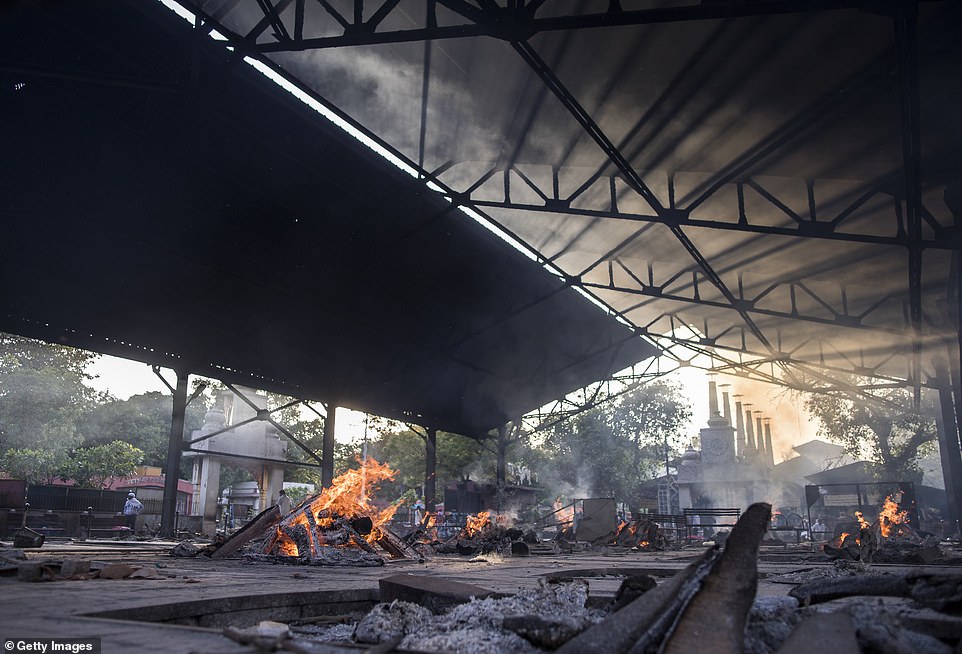
Burning pyres of patients who died of Covid-19 at a crematorium in Delhi over the weekend. The city of 29 million people has fewer than 100 beds with ventilators, and fewer than 150 beds available for patients needing critical care.
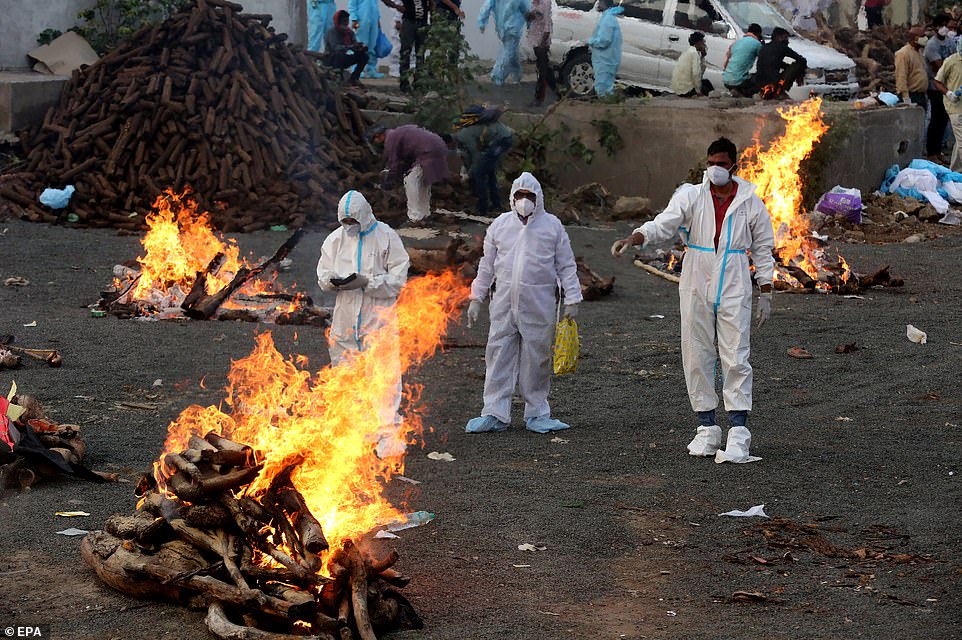
Relatives wearing personal protective equipment (PPE) walk amid burning funeral pyres as they perform last rites for covid-19 victims in Bhopal
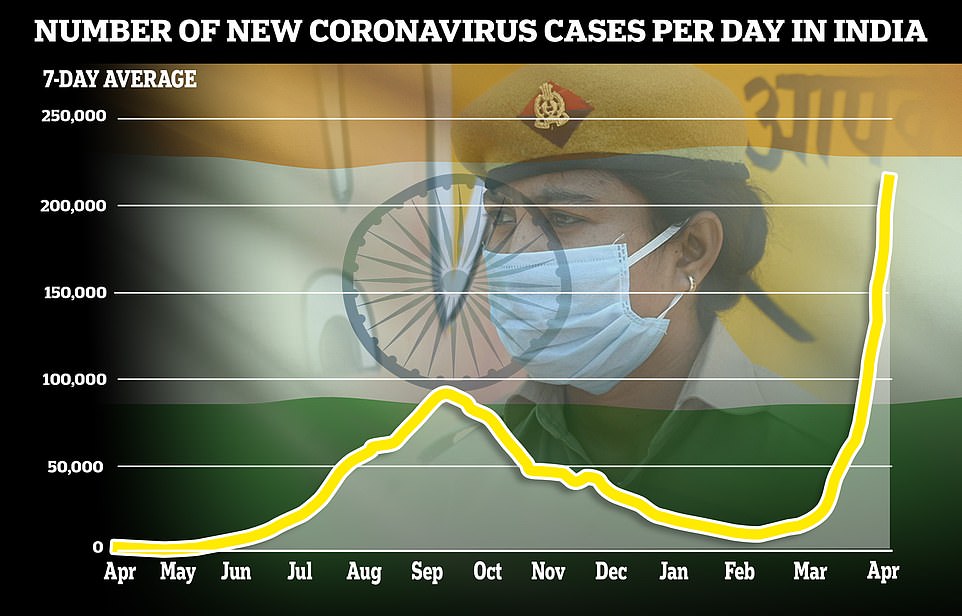
More than 200,000 cases per day were recorded on average in the last week, 20 times as many as two months ago, as a new variant of Covid-19 emerged which scientists fear could partly evade vaccines
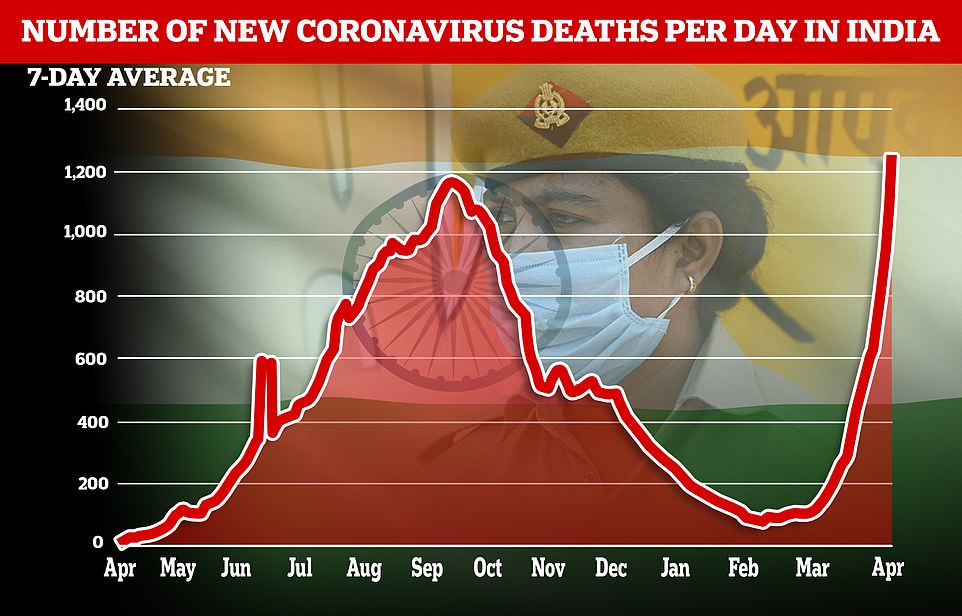
An average of 1,247 deaths were recorded over the last seven days, though India’s figures on Covid fatalities are believed to be vastly under-reported
‘Until last month we were cremating 20-odd bodies per day… But since the beginning of April we have been handling over 80 bodies every day,’ said a local official at the Ramnath Ghela Crematorium in the city.
With waiting times of up to eight hours, Rajkot has set up a dedicated 24/7 control room to manage the flow in the city’s four crematoria.
At two crematoria in Lucknow in the north, relatives are being given numbered tokens and made to wait for up to 12 hours. One has started burning bodies in an adjacent park.
Rohit Singh, whose father died from Covid-19, said crematorium officials were charging around 7,000 rupees (£67) – almost 20 times the normal rate.
Some crematoria in Lucknow ran out of wood and asked people to bring it themselves. Viral photos on social media showed electric rickshaws laden down with logs.
The rising death toll has also increased the grim workload for gravediggers dramatically in the last few weeks.
When AFP visited the Jadid Qabristan Ahle cemetery in the Indian capital – which is now in a week-long lockdown – on Friday, 11 bodies arrived within three hours.
By sunset, 20 bodies were in the ground. This compares to some days in December and January, when his earthmoving machine stayed idle and when many thought the pandemic was over.
‘Now, it looks like the virus has legs,’ said Shamim, 38, a gravedigger like his father and grandfather. ‘At this rate, I will run out of space in three or four days.’
Around the graveyard, white body bags or coffins made out of cheap wood are carried around by people in blue or yellow protective suits and lowered into graves.
Just months after India thought it had seen the worst of the pandemic, the virus is now spreading at a rate faster than at any other time, said Bhramar Mukherjee, a biostatistician at the University of Michigan who has been tracking infections in India.
As it battles the rising cases, India announced Monday that it would vaccinate everyone older than 18 from May 1.
The country began inoculating health workers in mid-January and later extended the drive to people over 45. India has so far administered 120 million doses to its population of nearly 1.4 billion.
The country reported over 270,000 infections on Monday, its highest daily rise since the pandemic started.
It has now recorded more than 15 million infections and more than 178,000 deaths. Experts agree that even these figures are likely under-reported.
Amid the rise in cases, Boris Johnson called off a trip to Delhi to hold post-Brexit trade talks with Narendra Modhi.
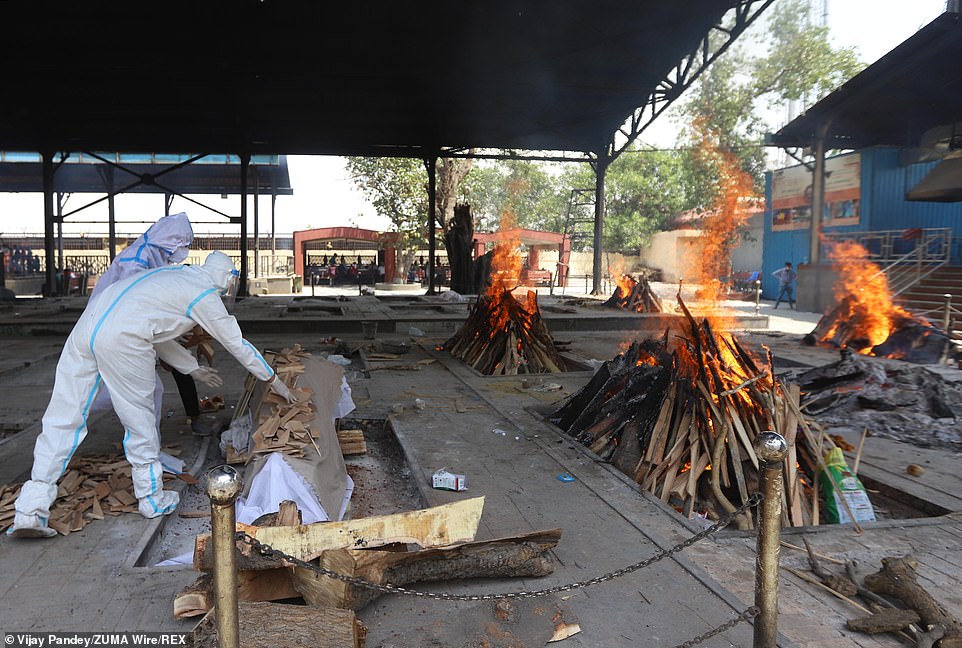
Burning pyres of patients who died of coronavirus at a crematorium in New Delhi
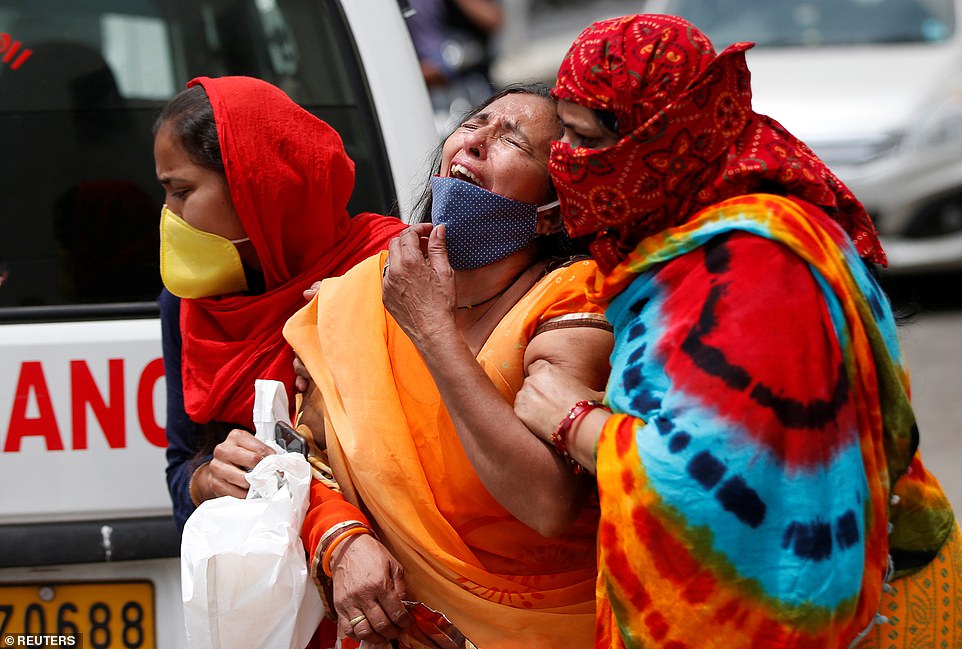
A woman is consoled after her husband died due to Covid outside a mortuary of a COVID-19 hospital in Ahmedabad
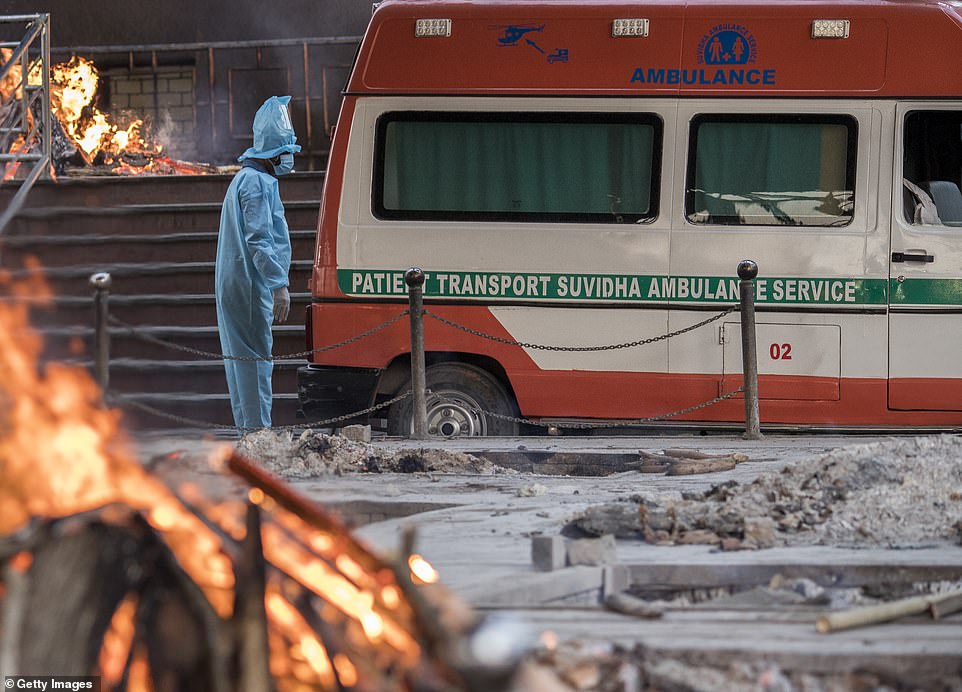
A man wearing PPE waits to transfer the body of his relative who died of the Covid-19 coronavirus infection from an ambulance amid burning pyres of other covid deaths at a crematorium in Delhi on April 17
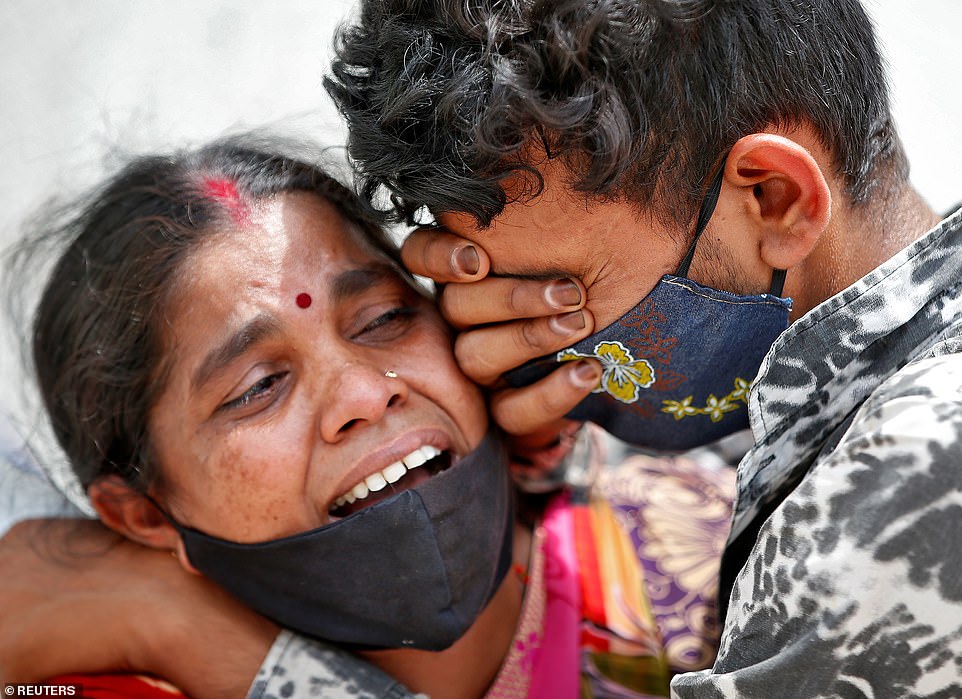
A woman mourns with her son after her husband died due to the coronavirus disease outside a mortuary of a COVID-19 hospital in Ahmedabad

A man in full PPE prepares to perform the last rites of his relative near multiple burning pyres of patients who died of the Covid-19 in Delhi
As well as Delhi, the country’s healthcare infrastructure is being tested across the land, including in the remote Himalayan region.
In Indian-controlled Jammu and Kashmir, the weekly average of Covid 19 cases has increased 11-fold in the past month.
In Telengana state in southern India, home to Hyderabad city where most of India’s vaccine makers are based, the weekly average of infections has increased 16-fold in the past month.
Meanwhile, election campaigns are continuing in West Bengal state in eastern India, amid an alarming increase there as well, and experts fear that crowded rallies could fuel the spread of the virus.
Top leaders of the ruling Bhartiya Janta Party, including Prime Minister Narendra Modi, have campaigned heavily to win polls in the region.
By contrast, in Delhi, officials have begun to impose stringent measures again.
The Indian capital was shut down over the weekend, but now authorities are extending that for a week: all shops and factories will close, except for those that provide essential services, like grocery stores. People are not supposed to leave their homes, except for a handful of reasons, like seeking medical care.

Health workers attend to a suspected covid-19 positive patient waits outside dedicated Covid-19 Health Centre in Mumbai
They will be allowed to travel to airports or train stations – a difference from the last lockdown when thousands of migrant workers were forced to walk to their home villages.
That harsh lockdown last year, which lasted months, left deep scars. Politicians have since been reticent to even mention the word. When similar measures were imposed in Mahrashtra state, home to the financial capital of Mumbai, in recent days, officials refused to call it a lockdown. Those restrictions are to last 15 days.
Kejriwal, the Delhi official, urged calm, especially among migrant workers who particularly suffered during the previous shutdown, saying this one would be ‘small.’
But many feared it would spell economic ruin. Amrit Tripathi, a laborer in New Delhi, was among the thousands who walked home in last year’s lockdown.’We will starve,’ he said, if the current measures are extended.
There will be no third wave of deaths – and I should know, writes PROFESSOR PHILIP THOMAS, the academic who has accurately predicted every stage of the pandemic so far
A welcome sense of normality is at last beginning to return to Britain. As shops and bars re-open and families reunite, the long ordeal of lockdown appears to be coming to an end.
Given the current positive trends, the Government’s target of full freedom by June 21 looks like it should be met.
But that is not the message conveyed by a number of pessimistic experts. Full of bleak foreboding, they warn that the lifting of Covid restrictions could plunge us into another health crisis.
Last week, Professor Jeremy Brown, a member of the Joint Committee on Vaccination and Immunisation (JCVI), told the BBC that ‘a big third wave could still end up with 30,000 to 50,000 deaths, potentially, if it was a similar sort of size to the previous waves.’
Gloom
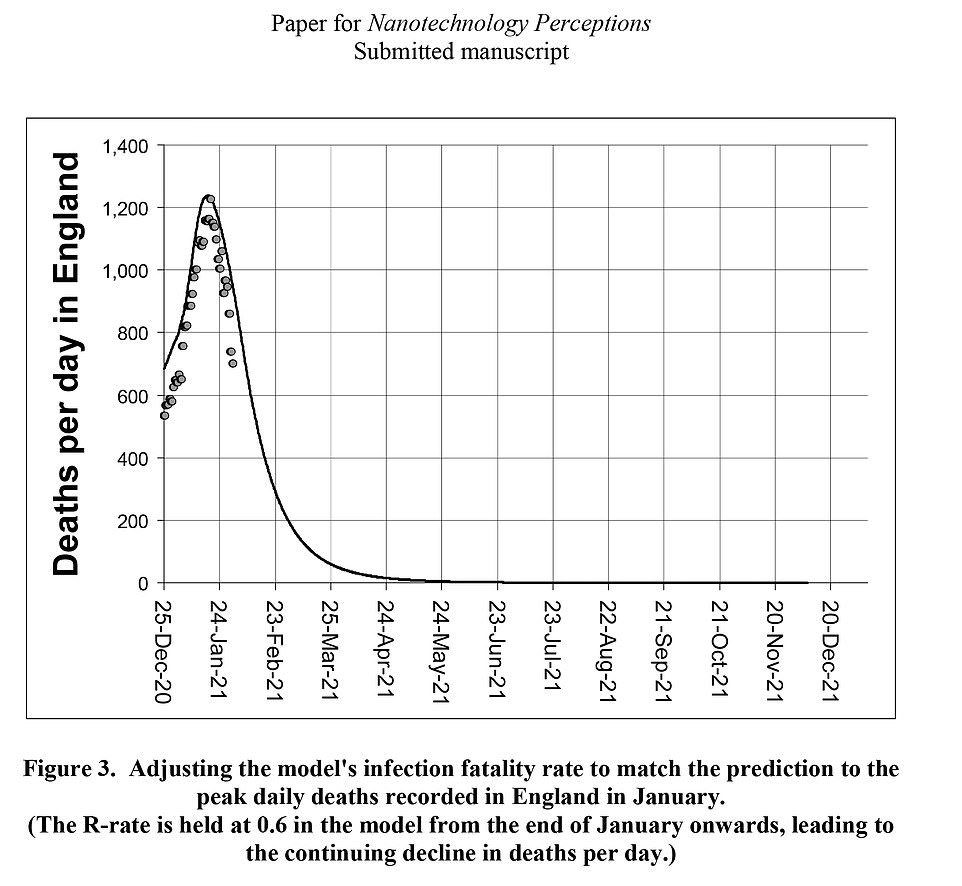
The model called the Predictor Corrector Coronavirus Filter (PCCF) looks at what will happen if the R-rate is held at 0.6

Professor Philip Thomas (pictured) believes negativity is overdone
In the same vein, at the beginning of the month, the Scientific Advisory Group for Emergencies (Sage) — whose modelling has provided the basis for the tough lockdown policy — warned that Britain is ‘highly likely’ to suffer a third wave, while any attempt to return to life as it was in February 2020 would probably result in ‘a big epidemic’.
This gloom has been compounded by fears about the advent of more infectious variants of the virus, such as the new B.1.617 type from India, whose spread across the subcontinent has just forced the Prime Minister to cancel his forthcoming visit there.
But as a scientist specialising in risk management, I believe this negativity is overdone. There is little convincing evidence to back the claim that, as lockdown is eased, Britain is about to be hit by a third wave, accompanied by a renewed surge in deaths.
On the contrary, it is my view that if there is indeed an increase in infections over the coming months, it will have little significant impact and the death toll will remain extremely low. That is because of the huge success of the vaccine programme, which will mean that by June, the overwhelming majority of the population is protected.
The reality is we are beating the pandemic. As we move into the summer, immunity will grow. In such circumstances, there would be no justification for keeping restrictive measures in place.
This optimism is based partly on the mathematical model I have created, which uses data to project the trajectory of the virus. This is tested against independent measurements made by the Office for National Statistics (ONS).
My work on modelling has proved accurate in the past, notably in the 1990s when there was deep concern in government circles about the incidence of bovine spongiform encephalopathy (BSE) — known as Mad Cow Disease — and its human equivalent, the brain disorder Creutzfeldt-Jakob disease (CJD).
Based on my analysis of the data, my contention made in 1996 was that CJD would claim 20 to 520 lives, with a central estimate of 130. That turned out to be remarkably close to the real figure of 180.
Advocate
In contrast, the official advisory team, led by Professor Sir Roy Anderson of Imperial College London, set out scenarios where the death toll ranged from 100 to 10 million.
Intriguingly, one member of Professor Anderson’s team was Professor Neil Ferguson, who has gained a high public profile during the Covid crisis as one of the most voluble advocates of lockdown.
In studying the coronavirus, I developed a model called the Predictor Corrector Coronavirus Filter (PCCF). It is a simple software device, inspired by the work of two pioneering Scots: the mathematical epidemiologist Anderson McKendrick and the biochemist William Kermack, who came up with a hypothesis that could track the spread of an infectious disease.
Like all models, the PCCF had a number of assumptions fed into it, including high levels of both the take-up and effectiveness of the vaccines, based on field data.
What the PCCF model indicates is that there is little danger of our society being overwhelmed by a third wave.
My prediction is that, although the total number of active infections in England could reach a peak of 160,000 in the early autumn of this year, this rise will not lead to a spike in deaths or hospitalisations.
That is because, thanks to the vaccines, the link between Covid infections and fatalities has been broken.
In this new, safer environment, roughly one third of people who are infected will have no symptoms at all, while the vast majority of the remainder will have only mild symptoms. As a result, even when the peak is reached, the death toll will probably be less than 20 per day.
I can have full confidence in this forecast because my PCCF model has proved reassuringly accurate over recent months. Its figures are updated daily online and, each week, they turn out to be retrospectively validated by the latest Covid report from the ONS, which surveys the population through the use of Covid tests on 150,000 participants every fortnight.
Every time, my own data and that of the ONS are reconciled almost exactly, which can hardly be said of all the predictions from Sage.
What the most recent findings prove for certain is the efficacy of the vaccines. That is why we are winning the war on Covid. Even the new variants are a far less deadly threat because the jabs have ‘drawn their sting’, to use the phrase of the epidemiologist Professor Andrew Hayward.
Before the programme started, there were concerns about hesitancy in the public to have the jab, but they have proved unfounded. According to the ONS, 65 per cent of England’s adult population have received at least one dose, while that figure rises to 97 per cent for the over-50s.
Moreover, they have proved even more effective than expected. My PCCF model has turned out to be justified in its assumptions that a first jab provides 69 per cent protection against infection and transmission, as well as reducing the chances of dying by 85 per cent after eight weeks.

What the most recent findings prove for certain is the efficacy of the vaccines. Pictured, Prime Minister Boris Johnson at a pub in Wolverhampton on Monday
Threat
So why are some other experts so pessimistic? I think it is because they are fixated by the goal of eradicating Covid, no matter what the social and economic cost, so they view any measure of freedom as a potential threat.
But this approach lacks any sense of perspective. It fails to take into account the huge collateral damage done by the lockdowns, including poor mental and physical health, financial insecurity, business failures and unemployment.
It has been cruel to the older people locked in care homes and to students trapped on university campuses. One clear indicator of a society’s prosperity is life expectancy. Thanks to the fall-out from lockdown, our average length of life in Britain may already be reducing, which means that people of all ages will die earlier than they should.
We have stored up colossal problems for the future. The last vestiges of lockdown should not continue a moment longer that was planned in the Government’s roadmap. And my model shows that they will not need to. That is a cause for celebration, not anxiety.
- Philip Thomas is professor of risk management at Bristol University.
